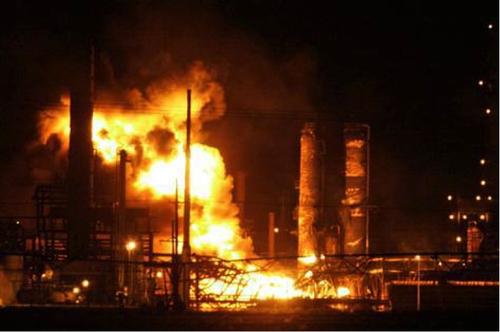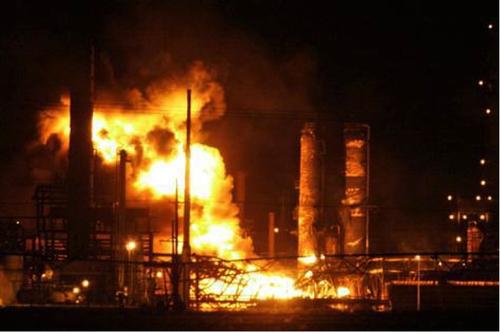Engineering Disasters: 1984 Romeoville Refinery Blast
January 7, 2015

On July 23, 1984, an explosion rocked the Union Oil Co. refinery in Romeoville, Ill., killing 17 workers and sending a 34-ton tower flying into a small field beyond nearby houses. According to the Chicago Tribune a second blast was so severe that an airplane flying 1,500 feet above the plant was struck by debris. A raging fire that followed the explosion flashed to temperatures of 4,000F.
The refinery disaster was one of the deadliest in US history. The explosion was felt, seen, and heard across much of the southwest suburban area. Residents of Romeoville, Lockport, and Lemont still talk about where they were or what they were doing when the explosion lit up the night sky like a mushroom cloud.
Union Oil noted that shortly before 6 p.m. that day, Bob Gomer was making a routine hourly check of a pressure tower and discovered a hairline crack in a circular weld. Bradley Turner, a truck driver from Munster, Ind., had just finished unloading sulfuric acid inside the plant when he heard an alarm.

Turner waited for the all-clear signal, but it didn't arrive. Gomer and his co-workers worked to close the pressure valve on the cracked tower. A spark caused an explosion and the workers "hit their bellies," according to Gomer. The second explosion rocked buildings 15 miles away, blew the windows out of a bank in Joliet, and sent smoke billowing 2,000 feet.
This vessel was an amine absorber tower used to strip hydrogen sulfide from a process stream of propane and butane. The vessel was 62 feet tall, 8.5 feet in diameter, and made from 25-mm-thick plates of type ASTM A516 Grade 70 steel. The explosive force had been able to propel the upper 46 feet of the vessel a distance of more than half a mile from its original location, while the base remained at the center of the fire that followed after the explosion.
Cracked courses from brittle steel
Magnetic particle inspection revealed a large number of cracks confined mainly to the inner surfaces along the welds between Courses 1 and 2 of the vessel and between Courses 2 and 3. Ultrasonic measurements then detected clear indications of separation of laminate to layers confined to Course 1. Thickness measurements, made with a micrometer, showed that Courses 1 and 2 had wall thickness well within the allowances for pressure vessels.
The tests showed that all initial and replacement components satisfied the industry standard specifications. The cause of the failure did not become clear until metallographic results were combined with stress corrosion cracking and hydrogen embrittlement tests, followed by a fracture mechanics analysis.

Hydrogen embrittlement
Upon further research, investigators found that an already existing crack had extended through more than 90% of the wall thickness and was about 800 mm in length. They also found that hydrogen embrittlement had reduced the fracture resistance of the steel by more than half. The vessel had been put into service in 1970 and had undergone several repairs and modifications before the July 1984 incident.
Hydrogen embrittlement is the process by which various metals, most importantly high-strength steel, become brittle and fracture following exposure to hydrogen. Hydrogen embrittlement is often the result of unintentional introduction of hydrogen into susceptible metals during forming or finishing operations and increases cracking in the material. This phenomenon was first described in 1875.
The vessel was fractured along a path that was weakened by extensive cracking adjacent to a repair weld joining a replacement section to the original vessel. These pre-existing cracks initiated in areas of hard microstructure known to be susceptible to hydrogen stress cracking. This hard microstructure formed during the repair welding of the replacement section. The cracks grew through the vessel wall as a result of hydrogen pressure cracking.
When the depth of the largest of these pre-existing cracks exceeded 90% to 95% of the wall thickness, the remaining thin ligament of steel in the cracked section ruptured and leakage occurred. This crack caused a complete fracture of the vessel circumference at the operating stress level of only 35 MPa (roughly 10% of the rated strength of the steel) because the toughness of the vessel steel had been reduced by hydrogen embrittlement.
Design engineers and professionals, the West Coast's most important design, innovation, and manufacturing event, Pacific Design & Manufacturing, is taking place in Anaheim, Feb. 10-12, 2015. A Design News event, Pacific Design & Manufacturing is your chance to meet qualified suppliers, get hands-on access to the latest technologies, be informed from a world-class conference program, and expand your network. (You might even meet a Design News editor.) Learn more about Pacific Design & Manufacturing here.
Related posts:
About the Author(s)
You May Also Like





